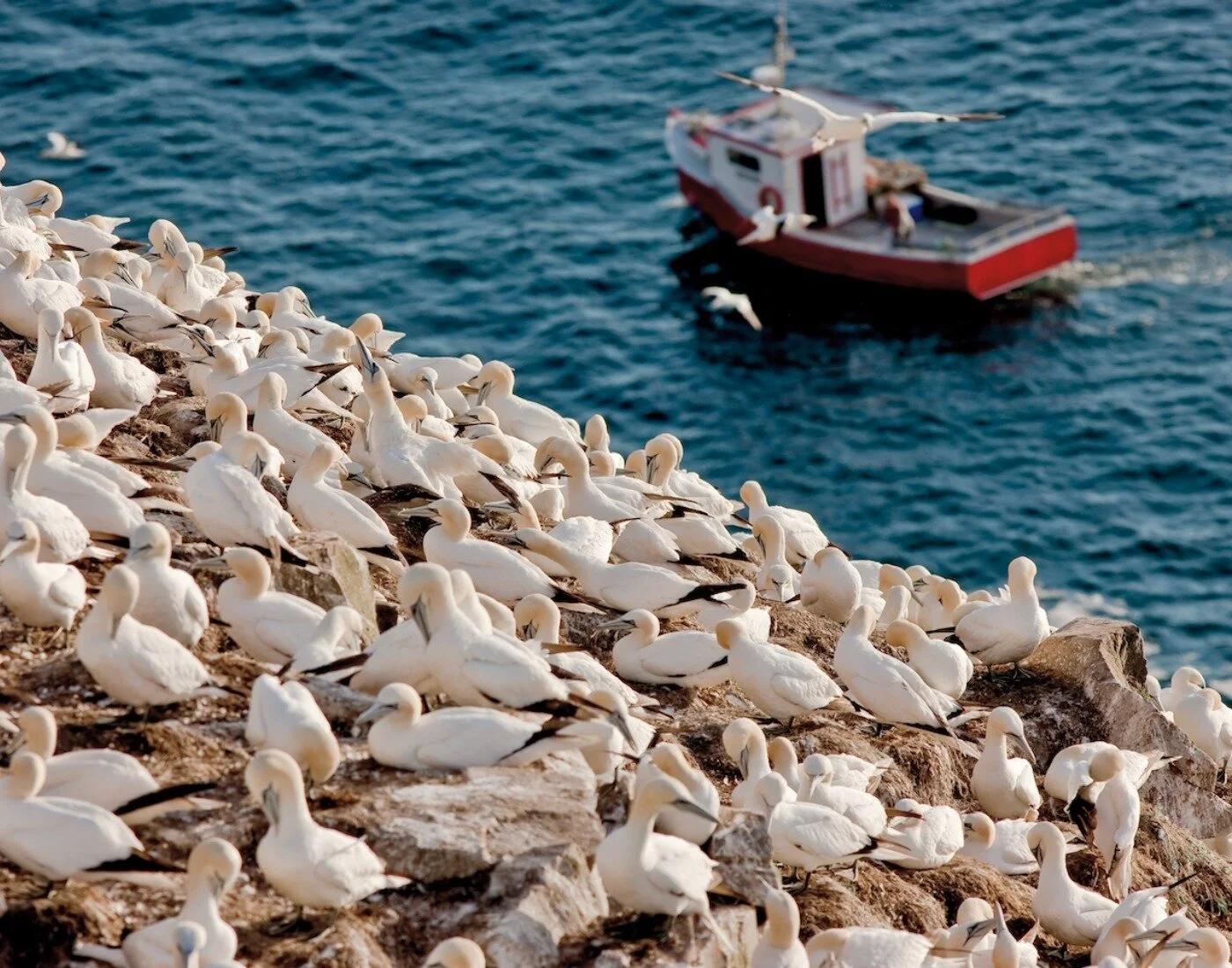Hanging with the big birds
On the Avalon Peninsula, puffins gather en masse to gorge on fish. Mary Roach drops in for the guided tour.
On the Avalon Peninsula, puffins gather en masse to gorge on fish. MARY ROACH drops in for the guided tour. I'm the kind of birder my mother was, which is to say, lazy. Mom hung a feeder from a bracket up against the living room window and bird-watched from the Barcalounger, in between sips of sherry and Jumble clues. It didn't seem to bother her that a percentage of her feathered pals would hurtle into the windowpane and drop, stunned, to the lawn below. I like to leave the living room, but I don't want to work too hard. I like my birds large and showy and abundant, eight or ten species all in one place. Newfoundland in summer is nirvana for the lazy birder: it has four rollicking seabird colonies, three within a half day's drive of each other on the Avalon Peninsula. In fog-bedeviled Avalon, you go where the sun is. This afternoon, that's Witless Bay Ecological Reserve, an hour's drive south of the city of St. John's. I sign on for a 4 p.m. boat trip to see puffins, razorbills, and murres at tiny Gull Island. No one knows who Witless Bay was named after - no doubt the witless soul who named the Atlantic's largest puffin colony Gull Island. Instead of merely stating that Atlantic puffins mate for life, he says, "They're really devout Christians."I'm sailing with Gatherall's Puffin and Whale Watch. Our guide is Liam Walsh, a gangly postadolescent with a plank-flat butt and a wraparound grin. Liam knows a lot about puffins, but you wouldn't mistake him for a naturalist. He calls them "hatchet faces" and "piss-poor flyers." Instead of merely stating that Atlantic puffins mate for life, he says, "They're really devout Christians." Ten minutes out to sea, I pull out my binoculars and try to make an I.D. on some dark blobs floating a hundred yards distant. As always happens on bird outings, someone comes along and trumps me. "Those by the rocks are thick-billed murres," says a woman in a yellow kerchief, somewhat thick-billed herself. "The ones on the water with their heads held high? Those are either cormorants or guillemots, which have a pink gullet. Can you see the inside of the mouth?" Yours, I can. She glances at my bird book. It's open to Auklets and Murrelets, which, I later note, are found nowhere on the Eastern seaboard. She asks, "Are you an experienced birder?" which in my jetlag-addled head summons an image of Jimi Hendrix with a spotting scope and a life list. The woman points to the water, 10 feet below us. "There's your first puffin, dear." "They're like young women," says Liam. "They take off their lipstick once they get what they're after." The puffins are off the end of the adorable meter. This is one of those rare instances of the real thing being cuter than the stuffed animal in the gift shops. It's how they do their eyes: a combination of Marcel Marceau and Elizabeth Taylor in Cleopatra. Also, it's the beak: orange and yellow and way too big. It's a wonder puffins survive. Imagine trying to fish with no hands, no rod, no tackle box, just an oversize nutcracker strapped to your face. Understandably, the birds shed the showy beak soon after the breeding season, in favor of a smaller, duller version growing underneath. "They're like young women," says Liam. "They take off their lipstick once they get what they're after." As though personally offended, the puffin takes off. With their stubby wings, puffins need a long runway. Unfortunately, the runway keeps swelling up underneath them. During takeoff, a puffin typically smashes headlong into a few waves before gaining altitude. The situation isn't helped by the fact that the average puffin, this time of year, is lugging a quarter pound of fish in its gut. He's over his baggage allowance. The aerodynamics are further compromised by the bird's stumpy tail. While other birds use their tails as rudders, puffins must use their feet, which dangle below them like mud flaps. Turns are iffy at best. Puffins seem to spend the bulk of their time hanging out on the front porch. This is understandable, given that their living room is a hole in the dirt. A tinny chatter fills the air. At first I take it to be someone's Walkman cranked up loud. It's not. It's birds off in the distance, thousands of them, all over Gull Island. Bird colonies have the same approximate ratio of bodies to ground surface as do outdoor rock concerts (and, judging from the smell, a similar dearth of Port-a-Potties). For every puffin on the ground, there appear to be two or three in the air, circling and swarming, thick as midges in July. They fly in giant "wheels" to frustrate predatory gulls, who are terminally indecisive. That one? No, that one. No, that one. Forget about it, I'll have fish. Murres, tall tuxedoed diving birds, line the island's blocky cliff walls. Theirs is an even odder security system. Murres protect their chicks by keeping them hidden between their chests and the rock wall. Their backs are always to you, giving them the shifty, up-to-no-good look of men relieving themselves in an alleyway. Puffins seem to spend the bulk of their time hanging out on the front porch. This is understandable, given that their living room is a hole in the dirt. Puffins don't build nests; they dig burrows. Even if they one day woke up to the fact that, as birds, they belong in trees, it'd be too late. Their burrowing has left the roots of the island's trees nowhere to go, and so the trees have died. There's something painfully ironic about eating birdseed while watching puffins gorge themselves on kippered herring snacks. Come September, Liam tells us, Gull Island is nothing but grass and guano. The seabirds return to the sea, living, like Gatherall's, off the fat of a summer's abundance. It's a hard life on the sea. Puffins sleep on the water. They socialize little. Only 10 percent will find enough fish to survive the three years they spend at sea before returning to Gull Island to breed. At the moment, though, there's plenty of fish. I'm the one who's starving. Liam puts a hand on my shoulder. "Did you get everything you need?" What I really need is a sandwich. I came straight from the airport, and have been sustaining myself on a bag of airport snack-shop sunflower seeds. I remark to Yellow Kerchief that there's something painfully ironic about eating birdseed while watching puffins gorge themselves on kippered herring snacks. Kerchief informs me that the fish in question is actually a capelin, a "smelt-like fish." The rest of the trip is spent idling on the bay, dreaming of fish and chips. A puffin dives, surfaces beak empty. I hold out my bag. "Want some sunflower seeds?" The puffin takes off, nearly smacking the side of our boat. Two others commence diving for fish 20 yards to starboard. My mother would have loved this place.
Mary Roach is a contributing editor of Vogue and Health. Her articles have also appeared in Discover, Outside, Men's Journal, Condé Nast Traveler, and The New York Times Magazine. She lives in San Francisco.

